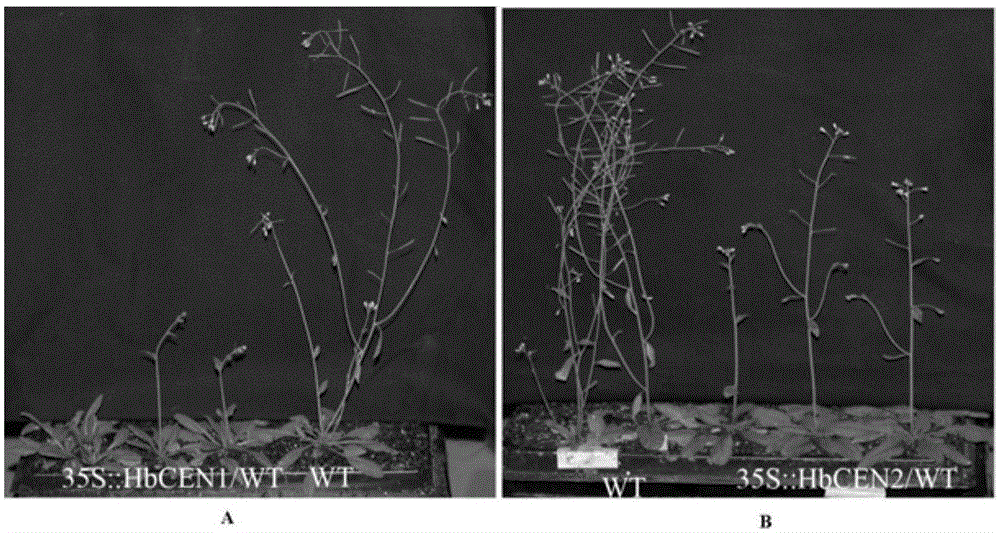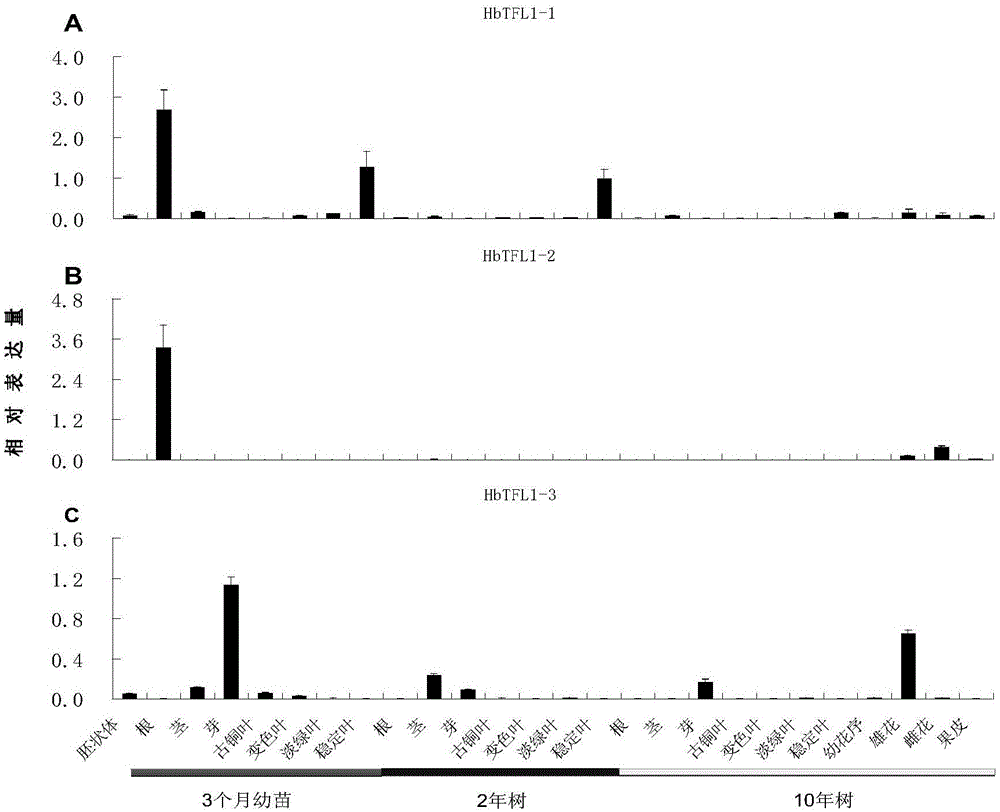Rubber tree blooming regulation protein HbCEN1, encoding gene thereof, and application of gene
A technology for flowering regulation and coding genes, which can be applied in the fields of application, genetic engineering, and plant gene improvement, and can solve the problems that have not yet been reported on TFL1/CEN-like genes
- Summary
- Abstract
- Description
- Claims
- Application Information
AI Technical Summary
Problems solved by technology
Method used
Image
Examples
Embodiment 1
[0031] Embodiment 1 Obtaining of 5 target genes of Hevea brasiliensis
[0032] According to the Rubber Tree Genome Database and Leaf Transcriptome Database of the Rubber Research Institute of the Chinese Academy of Tropical Agricultural Sciences, contigs obtained through homologous alignment are then spliced, and then the open reads are predicted by NCBI online software and specific primers are designed to obtain contigs containing complete open reads. DNA sequence and cDNA sequence of the reading frame.
[0033] The specific method is as follows:
[0034] Acquisition of open reading frames for 5 genes
[0035] The five gene-specific primers are as follows:
[0036] HbTFL1-1OF (EcoRI):G ATGTCAAGGATCATGGAGCC
[0037] HbTFL1-1OR(XbaI):GC TCATTCTTCTTCTTGCAGCAGTTTT
[0038] HbTFL1-2OF(EcoRI):G ATGGCAAGAATAATAGAACCTCT
[0039] HbTFL1-2OR(XbaI):GC TTAGCGCCTTCTTGCAGCAGTT
[0040] HbTFL1-3OF(EcoRI):G ATGGCAAGAATAATAGAACCTCT
[0041] HbTFL1-3OR(XbaI):GC TTAGCGTCTTCTT...
Embodiment 2
[0102] Example 2 Analysis of tissue-specific expression of 5 target genes
[0103] In this study, 3-month-old rubber tissue culture seedlings were selected as experimental materials. The roots, stems, buds, bronze leaves, discolored leaves, light green leaves and stable leaves were collected respectively, and their RNAs were extracted for future use.
[0104] The RNA obtained above was digested with DnaseI and then reverse transcribed according to the reverse transcription kit. The tissue-specific expression analysis of five target genes was performed by fluorescence quantitative technology.
[0105] The five gene fluorescent quantitative primers are:
[0106] HbTFL1-1QF:CCTCCTTAATCCCTGGCTACG,
[0107] HbTFL1-1QR:ACATCGCCTACAACTCTCCCT,
[0108] HbTFL1-2QF:GCCACATTTGGAAGGGAGATAG,
[0109] HbTFL1-2QR: TAACACTTATTTATTGAAGGCCACTTG,
[0110] HbTFL1-3QF: ATACACCTCTTAGCCAGACGCTC,
[0111] HbTFL1-3QR:TGTCGCCTCCTTGGACCTCA,
[0112] HbCEN1QF:CTAATGGCGAAGACAACAGAT,
[0113] HbCE...
Embodiment 3
[0117] Example 3 Analysis of spatiotemporal expression patterns of 5 target genes
[0118] Taking 3 months, 2 years and 10 years as the research objects, the roots, stems, buds, bronze leaves, color-changing leaves, light green leaves and stable leaves of each age group were collected in the flowering season (March) respectively, and 10 years old. RNA was extracted from the male and female flowers of the annual tree when they bloomed.
[0119] The RNA obtained above was digested with DnaseI and then reverse transcribed according to the reverse transcription kit. The temporal and spatial expression patterns of the five target genes were analyzed by fluorescence quantitative technology.
[0120] The results showed that: in the flowering season, for TFL1-like genes, the expressions of HbTFL1-1, HbTFL1-2 and HbTFL1-33 genes in their respective vegetative organs in 10-year-old trees were significantly lower than those in 3-month-old and 2-year-old trees . In the newly differenti...
PUM
 Login to View More
Login to View More Abstract
Description
Claims
Application Information
 Login to View More
Login to View More - R&D
- Intellectual Property
- Life Sciences
- Materials
- Tech Scout
- Unparalleled Data Quality
- Higher Quality Content
- 60% Fewer Hallucinations
Browse by: Latest US Patents, China's latest patents, Technical Efficacy Thesaurus, Application Domain, Technology Topic, Popular Technical Reports.
© 2025 PatSnap. All rights reserved.Legal|Privacy policy|Modern Slavery Act Transparency Statement|Sitemap|About US| Contact US: help@patsnap.com



